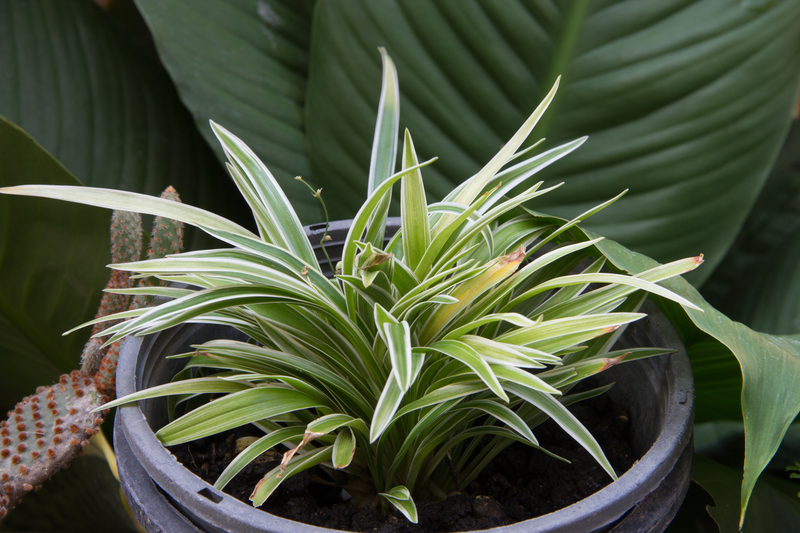Revolutionize urban spaces with vertical gardening
Posted on 30/06/2025
Revolutionize Urban Spaces with Vertical Gardening: The Future of Green Cities
What if the answer to modern urban challenges was growing right before our eyes--literally up the walls of our cities? Vertical gardening offers a transformative approach to urban greening, environmental sustainability, and community well-being.
Why Vertical Gardening Is the Urban Revolution We Need
Today, our cities are crowded, bustling, and, unfortunately, often lacking in green spaces. As concrete jungles rise, the need for sustainable and eco-friendly solutions becomes more pressing. Vertical gardening, also known as living walls, green walls, or vertical green spaces, is reshaping our urban landscapes like never before.
- Maximizes limited space: Perfect for cities where horizontal room is scarce.
- Improves air quality: Plants act as natural air filters.
- Enhances aesthetics and wellbeing: Greener environments promote mental health and happiness.

The Concept: What Is Vertical Gardening?
Vertical gardening is the practice of growing plants on vertically suspended panels or structures. These gardens are attached to walls, fences, or specially designed freestanding frames, transforming blank walls and unused spaces into lush, green environments. This innovative gardening technique is gaining colossal popularity in urban landscaping, not only for its beauty but also for its functional benefits.
Types of Vertical Gardens
- Living Walls (Green Walls): Complete panels of plants integrated onto building walls.
- Modular Green Systems: Pot or tray-based systems arranged vertically.
- Pocket Planters: Fabric or felt pouches attached to walls, perfect for herbs and flowers.
- Climbing Gardens: Using trellises or wires for climbing plants like ivy, peas, or beans.
Where Vertical Gardens Can Be Used
There is nearly no limit to where vertical garden designs can be implemented:
- Residential balconies and patios
- High-rise apartment buildings
- Commercial and office complexes
- Schools and educational institutions
- Public spaces, plazas, and recreational areas
- Restaurants, hotels, and shopping centers
The Multiple Benefits of Urban Vertical Gardening
Transforming urban spaces with vertical gardening isn't just about aesthetics--though it certainly delivers on style. The impact goes much deeper, addressing key urban issues:
Environmental Benefits
- Air Purification: Plants absorb carbon dioxide and release oxygen, filtering dust and pollutants--and making cities healthier.
- Temperature Regulation: Green walls create natural insulation, lowering the urban heat island effect by cooling surfaces and shading buildings.
- Noise Reduction: Plant-covered surfaces can absorb sound, offering a quieter, more peaceful city life.
- Stormwater Management: Vertical gardens minimize rainwater runoff and support better water management.
Social and Wellbeing Benefits
- Improved Mental Health: Studies show that greenery in cities boosts mood and reduces stress.
- Space for Community Interaction: Green walls can become focal points for gathering and education.
- Food Security: Urban vertical gardens make it easier to grow fresh food in limited space, supporting local food systems and healthy eating.
Economic Advantages
- Increased Property Value: Green, sustainable features add real estate appeal.
- Energy Savings: Insulating green walls reduce the need for air conditioning and heating.
- Job Creation: The city-wide adoption of vertical gardening opens new avenues for urban farming and horticultural experts, designers, and installers.
How to Get Started with Urban Vertical Gardening
If you're inspired to revolutionize your urban space with vertical gardening, the journey begins with planning. Whether for your home, business, or community, follow these essential steps:
Step 1: Evaluate Your Space
- Sunlight: Assess how much natural light your wall receives. Choose shade-loving or sun-friendly plants accordingly.
- Surface: Identify a sturdy, flat surface for installation--walls, fences, or even freestanding frames.
- Access to Water: Ensure close access to a water source for irrigation.
Step 2: Select the Right Vertical Gardening System
- Pocket Planters: Ideal for beginners and small spaces; great for herbs, succulents, or flowers.
- Living Wall Panels: Modular systems with built-in irrigation, perfect for large displays.
- Recycled and DIY Structures: Use old pallets, bottles, or other recyclable items for a creative and sustainable approach.
Step 3: Choose Suitable Plants
- Herbs and Edibles: Mint, basil, lettuce, strawberries--grow your own food at home.
- Flowers: Add color and fragrance with petunias, pansies, or begonias.
- Ferns and Shade Plants: For north-facing walls or shaded areas.
- Succulents: Drought-resistant, low-maintenance, and visually striking.
Step 4: Install and Maintain Your Vertical Garden
- Mounting: Secure your chosen system to the wall or frame, ensuring weight support.
- Irrigation: Manual watering for small projects or automated drip irrigation for larger systems.
- Fertilizing: Regularly use appropriate fertilizers for vibrant growth.
- Pruning and Plant Care: Maintain health and beauty with occasional pruning and pest control.
Creative Ideas to Revolutionize Your Space with Vertical Gardening
- Edible Walls: Grow kitchen herbs and lettuces on your balcony for a "living pantry."
- Artful Patterns: Design plant walls with color and texture patterns for visual impact.
- Hydroponic Vertical Farms: Use soilless systems for efficient, high-yield urban farming.
- Community Green Walls: Collaborate with neighbors or local councils to green public spaces.
- Corporate Wellness: Install living walls in offices for improved air and worker productivity.
- School Gardens: Teach children about sustainability while greening playgrounds or cafeterias.
Overcoming Challenges in Urban Vertical Gardening
While the concept of vertical urban gardening is exciting and transformative, it's important to recognize and mitigate potential challenges:
- Structural Support: Ensure that walls or structures can handle the added weight of plants, soil, and water.
- Water Management: Choose waterproof backing, proper drainage, and reliable irrigation systems to avoid water damage.
- Plant Selection: Opt for hardy plant species suitable for your climate and micro-environment.
- Maintenance: Plan for regular upkeep, pruning, and the management of pests or diseases.
- Initial Costs: While some systems can be expensive, long-term benefits in energy savings and property value often outweigh the upfront investment.
Case Studies: How Cities Are Revolutionizing Urban Landscapes with Vertical Greenery
Sydney's One Central Park
This eco-savvy residential complex features stunning vertical gardens designed by botanist Patrick Blanc. With over 35,000 plants growing up its facade, it dramatically improves thermal efficiency and elevates residential living standards.
Singapore's Visionary Approach
Singapore has become a global leader in vertical gardening, mandating green walls on buildings through various incentives and regulations. The city's iconic Gardens by the Bay and the Oasia Hotel Downtown demonstrate how lush, living architecture is redefining urban space.
Paris's Musee du Quai Branly
The museum's living wall is a vertical ecosystem in the city center, blending art, nature, and urban design--and becoming a tourist landmark in its own right.
Vertical Gardening: Sustainability Meets Urban Innovation
The need to revolutionize our cities with vertical gardening has never been clearer. As populations grow and urban density rises, every square meter matters. Vertical gardens are unlocking the hidden potential of our built environment, with far-reaching impacts for sustainability, health, and community vitality.
Sustainable Cities of the Future
- Ecological Footprint: Green walls are crucial for reducing the environmental impact of built areas.
- Biodiversity: Urban vertical gardens provide habitats for pollinators and beneficial insects.
- Adaptability: Whether small-scale and residential or massive and commercial, green walls can fit nearly any urban context.
Tips for Making the Most of Your Vertical Garden
- Start Small: Begin with a manageable system to learn the basics, then scale up as you gain experience.
- Get Creative: Mix plant species, textures, and colors for a lively wall tapestry.
- Go Native: Use native or drought-resistant plants for easier maintenance and better ecosystem services.
- Engage the Community: Shared green projects foster a sense of ownership and pride in public spaces.
- Monitor Regularly: Check for signs of disease, pests, or water issues to catch potential problems early.

Frequently Asked Questions About Vertical Gardening in Urban Spaces
Q: How durable are vertical gardens in harsh climates?
A: Modern green wall systems are designed for a variety of climates. By choosing climate-appropriate plants and ensuring proper irrigation and insulation, vertical gardens can thrive everywhere from hot, arid cities to cool, temperate regions.
Q: Is it expensive to install a vertical garden?
A: Costs vary. DIY solutions can be budget-friendly, while commercial installations may require more investment. Over time, energy savings, improved wellbeing, and increased property values provide an excellent return.
Q: Can a vertical urban garden be edible?
A: Absolutely! Many city dwellers are converting blank walls into productive mini-farms, growing everything from herbs to strawberries and leafy greens.
Q: How much maintenance does a vertical garden require?
A: Regular watering, pruning, pest management, and feeding are essential. Automated irrigation systems can help minimize routine effort, especially for larger gardens.
Conclusion: Greening the Future with Revolutionary Vertical Gardening
Vertical gardening is more than a trend--it's a sustainable solution whose time has come. By embracing vertical garden systems, cities can convert unused, unappealing spaces into vibrant, life-affirming eco-hubs that benefit everyone. From its undeniable environmental advantages to its social, economic, and aesthetic contributions, vertical gardening is poised to revolutionize urban spaces for generations to come.
Whether you are a city planner, business owner, homeowner, or gardener, now is the time to turn your blank walls into living artwork. Transform your city--one vertical garden at a time!



